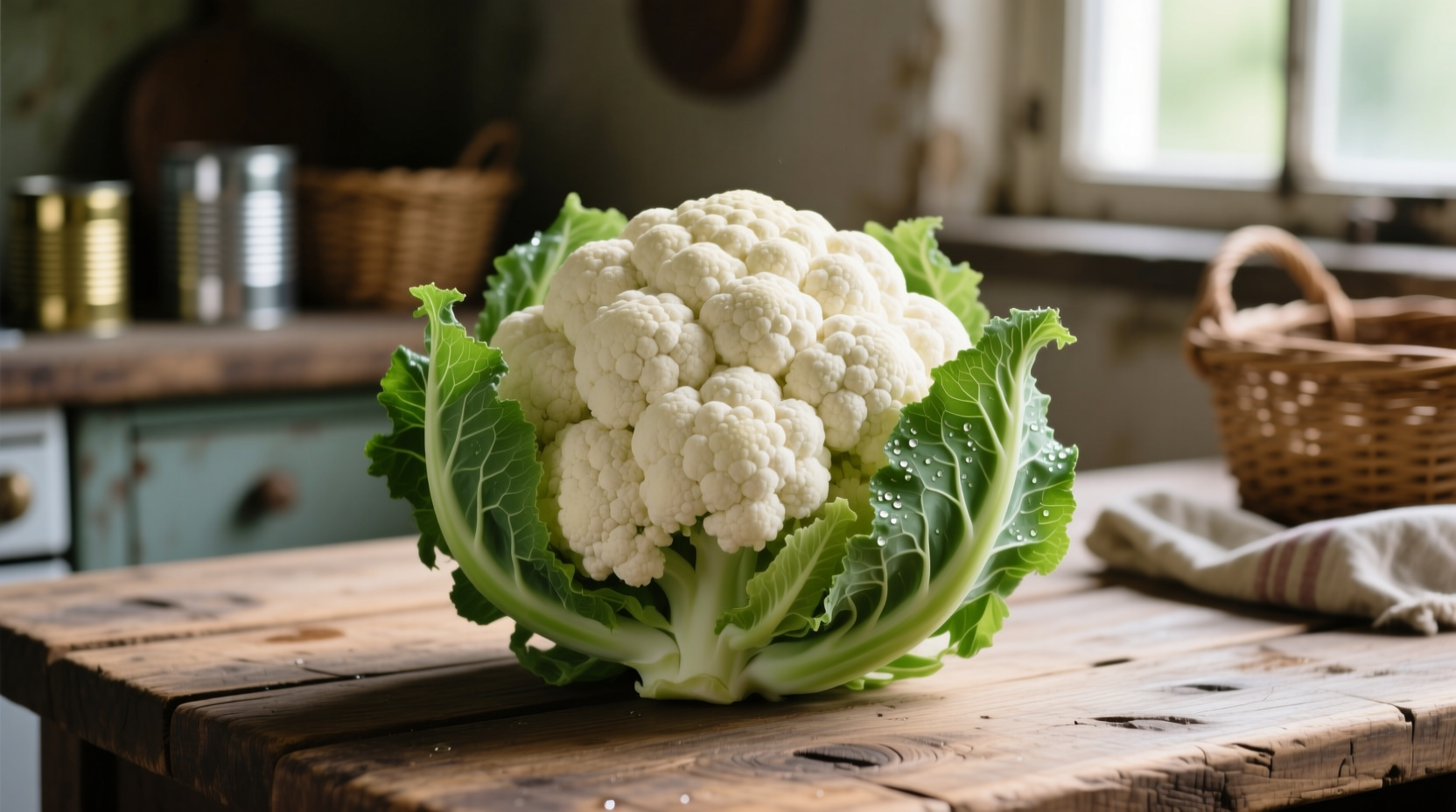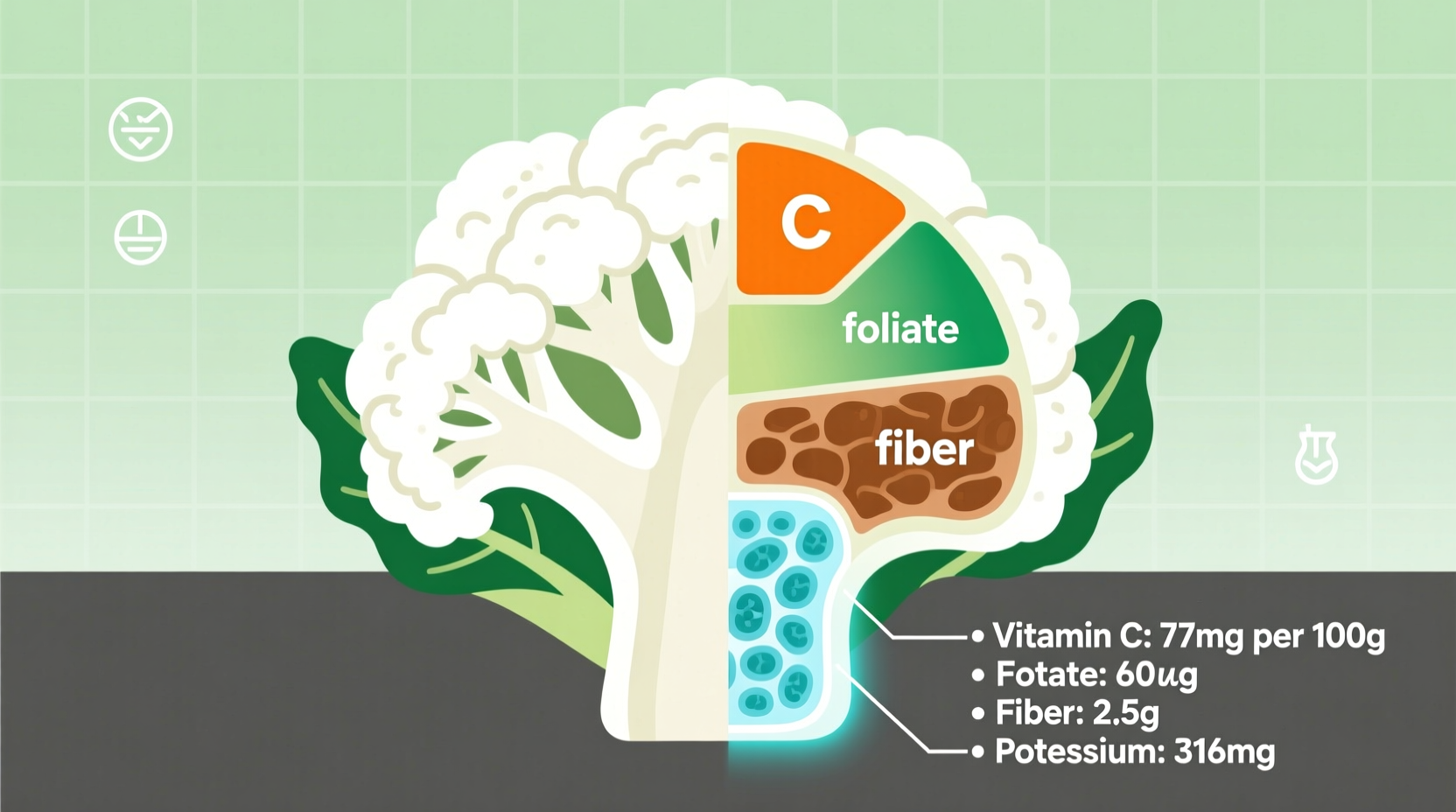Discover why this versatile vegetable deserves a regular spot on your plate. Whether you're managing dietary restrictions, seeking weight management solutions, or simply optimizing your nutrition, cauliflower offers remarkable benefits backed by scientific research. Let's explore exactly what makes this humble vegetable a nutritional powerhouse.
What Makes Cauliflower a Superfood?
Often overshadowed by its green cousin broccoli, cauliflower quietly delivers exceptional nutritional value. This white vegetable belongs to the Brassica oleracea species, sharing genetic roots with broccoli, kale, and cabbage. Its distinctive white color comes from the absence of chlorophyll, but don't let its pale appearance fool you—cauliflower contains potent phytochemicals that provide significant health advantages.
| Nutrient | Per 100g Raw | Daily Value % |
|---|---|---|
| Calories | 25 kcal | 1% |
| Protein | 1.92 g | 4% |
| Fiber | 2 g | 7% |
| Vitamin C | 48.2 mg | 54% |
| Vitamin K | 15.5 µg | 13% |
| Folate | 57 µg | 14% |
Source: USDA FoodData Central (2023)
Key Nutrients and Their Health Impacts
Cauliflower's nutritional profile extends far beyond basic vitamins and minerals. Its true power lies in specialized compounds that interact with your body in remarkable ways:
Vitamin C Powerhouse
One cup of raw cauliflower provides more vitamin C than an orange. This essential antioxidant:
- Strengthens immune function by supporting white blood cell production
- Promotes collagen synthesis for healthy skin and connective tissues
- Enhances iron absorption from plant-based foods
- Protects cells from oxidative damage that contributes to chronic disease
Folate for Cellular Health
With 57 micrograms per 100 grams, cauliflower ranks among the top vegetable sources of folate. This B-vitamin plays critical roles in:
- DNA synthesis and repair
- Red blood cell formation
- Preventing neural tube defects during pregnancy
- Homocysteine regulation, supporting cardiovascular health
Glucosinolates: Nature's Defense Compounds
Cauliflower contains glucosinolates, sulfur-containing compounds that transform into biologically active isothiocyanates when chopped or chewed. Research from the National Cancer Institute indicates these compounds:
- Activate detoxification enzymes in the liver
- May inhibit tumor growth through multiple mechanisms
- Exhibit anti-inflammatory properties at the cellular level
- Help regulate cell cycle progression

Cauliflower vs. Other Cruciferous Vegetables
While all cruciferous vegetables offer health benefits, cauliflower has unique advantages worth considering:
| Vegetable | Calories (per cup) | Vitamin C (mg) | Fiber (g) | Unique Compounds |
|---|---|---|---|---|
| Cauliflower | 25 | 77 | 2.5 | I3C, DIM, sulforaphane |
| Broccoli | 55 | 81 | 2.4 | Higher sulforaphane concentration |
| Brussels Sprouts | 56 | 75 | 3.3 | Higher vitamin K content |
| Cabbage | 22 | 37 | 2.2 | Anthocyanins (red varieties) |
Source: USDA National Nutrient Database for Standard Reference
What makes cauliflower particularly valuable is its versatility and neutral flavor profile. Unlike stronger-tasting cruciferous vegetables, cauliflower readily absorbs other flavors while providing similar nutritional benefits. This makes it an excellent choice for those transitioning to more plant-based eating patterns or managing dietary restrictions.
Maximizing Nutritional Benefits Through Preparation
How you prepare cauliflower significantly impacts its nutritional value. Research from the Journal of Agricultural and Food Chemistry reveals:
- Raw consumption preserves maximum vitamin C and enzyme activity but may cause digestive discomfort for some individuals
- Steaming for 5 minutes increases antioxidant availability while preserving glucosinolates better than boiling
- Roasting at 400°F develops complex flavors through the Maillard reaction without significant nutrient loss
- Avoid prolonged boiling which can leach water-soluble vitamins and reduce glucosinolate content by up to 60%
For optimal nutrient retention, chop cauliflower and let it sit for 5-10 minutes before cooking. This allows myrosinase enzymes to activate and convert glucosinolates into their beneficial forms. Pairing cauliflower with black pepper enhances absorption of fat-soluble compounds, while adding healthy fats like olive oil improves uptake of carotenoids.
Special Considerations for Specific Health Goals
Cauliflower's nutritional profile makes it particularly valuable for certain health objectives:
Weight Management Support
With only 25 calories per cup and 2 grams of fiber, cauliflower creates volume without excess calories. Its high water content (92%) promotes satiety, making it an excellent substitute for higher-calorie ingredients. Try these swaps:
- Riced cauliflower instead of grain-based rice (80% fewer calories)
- Cauliflower mash instead of traditional mashed potatoes
- Cauliflower crust for pizza (reduces carbs by 75% compared to wheat crust)
Heart Health Benefits
The fiber, potassium, and antioxidant compounds in cauliflower contribute to cardiovascular protection. A 2022 study published in the American Journal of Clinical Nutrition found that regular cruciferous vegetable consumption correlated with:
- 5-8% reduction in LDL cholesterol levels
- Improved arterial flexibility
- Lower markers of inflammation like C-reactive protein
Brain Health Connection
Choline, present in significant amounts in cauliflower (44.3 mg per cup), plays a crucial role in brain development and function. Research from the National Institutes of Health indicates choline supports:
- Memory formation and cognitive processing
- Neurotransmitter production
- Reduced risk of age-related cognitive decline
Practical Ways to Incorporate More Cauliflower
Move beyond basic steaming with these nutritionally optimized preparation methods:
Breakfast Boosters
- Add riced cauliflower to morning scrambles (increases vegetable intake without altering flavor)
- Create cauliflower-based breakfast bowls with eggs and avocado
Lunchtime Innovations
- Make cauliflower hummus using blended cauliflower instead of chickpeas
- Prepare cold cauliflower salad with lemon-tahini dressing
Dinner Transformations
- Roast cauliflower steaks with turmeric and garlic for enhanced anti-inflammatory effects
- Create creamy sauces using pureed roasted cauliflower instead of dairy
Addressing Common Concerns
Some people avoid cauliflower due to misconceptions about its nutritional value or digestibility. Let's clarify:
- Gas and bloating: Start with small portions and gradually increase intake to allow your digestive system to adapt. Cooking methods like roasting can improve digestibility.
- Nutrient loss during cooking: While some water-soluble vitamins decrease with cooking, the bioavailability of certain antioxidants actually increases. Steaming preserves most nutrients effectively.
- Goitrogen concerns: The goitrogens in cauliflower that might affect thyroid function are significantly reduced through cooking and pose minimal risk for those with healthy thyroid function consuming normal portions.











 浙公网安备
33010002000092号
浙公网安备
33010002000092号 浙B2-20120091-4
浙B2-20120091-4